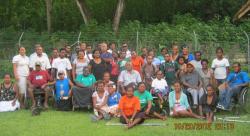People with Disabilities Association

1. INTRODUCTION
The Solomon Islands National Policy on Disability 2005 - 2010 was endorsed by Cabinet in November 2004. Prior to its endorsement, the Policy was consulted upon throughout the country with many stakeholders during 2004. The review of this Policy was conducted by the United Nations Economic and Social Commission for Asia and the Pacific (UNESCAP) Pacific Office from December 2012 to March 2013. During this time, numerous individuals, Ministries of the Solomon Islands Government and organizations were consulted both on the implementation of the original policy as well as planning for a future policy. A consultation with People with Disabilities Solomon Islands (PWDSI) took place in December 2013 and a multistakeholder consultation to discuss the draft revised policy was held in February 2013 in Honiara. Further consultations took place in Malaita, Western and Guadalcanal provinces in August 2013.
The 2005 - 2010 Policy contained 11 Objectives and some 56 tasks although many tasks had numerous subtasks. Some objectives involved mainstreaming disability within the Solomon Islands Government (SIG) while others were disability specific, which is termed a ‘twintrack approach’. The broad scope of the policy was ambitious, especially given the capacity to implement within the SIG in 2004. Of the eleven objectives, nine had some activity, although none were completely achieved. Approximately 11 tasks (20 per cent) were achieved and a further six (ten per cent) were partly achieved or were in process at the time of the review. Roughly a third of the tasks had some level of implementation. This is only an approximate estimate as achievements did not always exactly match the tasks prescribed by the Policy.
Some significant accomplishments included the national survey on disability that took place in 2005. This was a major undertaking and set a baseline for data, which was updated during 2012 and 2013 by CBR staff. The establishment of Bethesda Vocational Centre, which provides 10 weeks of shortterm training for youth with physical disabilities; San Isidro Training Centre, which provides medium to longterm training for deaf youths; are positive achievements. The continued consolidation of Community Based Rehabilitation (CBR) services throughout the country and the upgrading of the skills of CBR staff and the provision of assistive equipment through CBR are all strong points. The prominence given to children with disabilities in the National Education Action Plan and subsequent work towards inclusive education are encouraging signs of commitment from the SIG, although some of these activities have taken place outside of the implementation period of the National Disability Policy. Heightened awareness of the issue of disability and the increased capacity of People with Disabilities Solomon Islands (PWDSI) are also positive achievements.
It is safe to say that many of the achievements in disability have been made largely coincidentally to the Policy, rather than because of it. Many activities relating to disability have been fragmented and ad hoc, lacking an overall strategy or direction. The Policy has clearly not been used as a guiding document or planning tool and the Review found that most Government staffs were not familiar with it. One of the key issues in the relatively weak implementation of the policy was the lack of a dedicated position within the SIG to drive the implementation and to ensure that it was reported on. Although it evolved that the CBR section of the Ministry of Health and Medical Services (MHMS) was the focal point for disability in the SIG, this was an informal expectation that was added to CBR’s core role of a technical service provider. It was an unrealistic expectation that the CBR officer would be able to integrate disability issues across the SIG.
Some positive activities that have contributed to the betterment of the lives of PWD have taken place and were not in the Policy and these are noted in the Review. For example, CBR has worked with the water and sanitation division of MHMS to improve the bathrooms in homes of some PWD and some houses for PWD have been constructed, notably in the Guadalcanal.
Conclusion Remarks
1. LESSONS LEARNED
The main lesson learned from the first Disability Policy is that a policy cannot be effectively implemented when there is no dedicated officer in the SIG to drive its implementation and coordination. However the establishment of such a position was not included in the Policy. There was noone to advocate for the Policy or to ensure that it was widely known in the different ministries of the SIG that had been earmarked as having different responsibilities. This review found that there was a general lack of awareness of the existence of the Disability Policy in most government ministries, even the MHMS.
The lack of a dedicated person is linked to the fact that a National Coordinating Council on Disability was not established. The NCCD was meant to be the key mechanism in coordination between different stakeholders and reports on implementation of the Policy should have been made to it. Since there was no NCCD, there was nowhere to direct reports on implementation of the policy thus there was no reporting.
This Review has found that without these two enabling mechanisms, implementation of the Policy was sporadic and it was not able to serve its intended purpose of being a guiding strategic document.
Although the rights of persons with disabilities (PWD) are firmly acknowledged in the Policy, the main implementing agents were almost all Government. PWD are implicitly seen as passive recipients of Government actions, rather than being key stakeholders and implementers of the Policy. This resulted in PWD having little ownership of the Policy. Given the increased capacity of PWDSI, it is now in a better position to become an implementing agency in the revised Policy.
All of the 11 objectives in the Policy cover areas that are internationally acknowledged as important in realizing the rights of PWD and improving their lives. Yet in a resource-poor, postconflict setting with limited human or financial resources, it can be viewed with hindsight as too ambitious. The multitude of activities contained in it could not possibly be achieved in the six years of the life of the Policy.
We hope that by knowing the challenges faced by Persons with Disabilities Solomon Islands, people will stretch their arms to support our good course of serving the needs and aspirations of our disability community in the country.
The People with Disabilities Solomon Islands is a nonprofit organization for people with disabilities in the Solomon Islands and the organization is registered Act (Chapter 55) of 1996 of the Laws of Solomon Islands.
The organization has a General Bank Account with the Australia and New Zealand Banking Corporation (ANZ) in Honiara, the capital of the Solomon Islands.
Please get in touch with the President of the Association to donate to the worthy charitable and deserving organization.
One particular objective is to establish a Disability Centre in Honiara where the disabled can meet and be given assistance with job skills development to aid their work access and opportunities.
STATISTICS
- The 2009 Solomon Islands National Population and Housing Census[i]reports that 14 percent of the total population or 72,222 people – live with disability. This census figure is near the global prevalence rate of 15 per cent,[ii] which would suggest that a total of 77,381 Solomon Islanders live with disability. It is noteworthy that while the census questions focused on difficulties or health problems regarding seeing, hearing, walking (‘lameness’) and/or remember or concentrating (‘senile and/or amnesic’), they were not based on the WHO International Classification of Function and did not use rightsbased language. The census found:
- Minimal gender disparity in disability prevalence rates, with the proportion of females living with disability being slightly higher than that of males;
- 142,418 impairments among the population who reported disability;
- Ten per cent of children younger than five (5) years of age had disability and less than five (5) per cent of youth aged 519 years reported disability;
- The proportion of people with disability increased with age with approximately 50 per cent of those aged 5559 years reporting difficulties;
- Twenty per cent of the total population of people with disability were in Guadalcanal and Malaita.
- A comprehensive Solomon Islands disability survey undertaken in 2005 identified 14,403 individuals with disability, which equated to 3.52 per cent of the total population at that time. The same survey found that 25.6 per cent of people with disability were under the age of 20.
Solomon Islands National Statistics Office (2009a) 2009 Population and Housing Census: National report, Volume 2. Retrieved on 23 May 2014 from http://www.spc.int/prism/solomons/index.php/sinsodocuments?view=download&fileId=59; Solomon Islands National Statistics Office (2009b), Solomon Islands stats at a glance.Retrieved on 7 April 2014 from http://www.spc.int/prism/solomons/; Solomon Islands Government (2009) Statistical bulletin 06/2011: Report on 2009 Population and Housing Census. Retrieved on 6 April 2014 from http://www.mof.gov.sb/Libraries/Statistics/2011_06__Report_on_2009_Population_Housing_Census.sflb.ashx
WHO and World Bank (2011), p.28.
Solomon Islands Government (2009).
Ministry of Health and Medical Services (2005), Solomon Islands Nationwide DisabilitySurvey 2005, p 7.
NATIONAL STRATEGIC PLAN 2015 -2020
Honiara, Solomon Islands
1. INTRODUCTION
People With Disabilities Solomon Island (PWDSI) is a national, self-help non-profitable organization with headquarters in Honiara, Solomon Islands. The organization was formerly known as DPRA and DPASI. PWDSI advocates for the full recognition and expression of the rights and responsibilities of people with disabilities in Solomon Islands. This includes their active participation in all areas and levels of the society. In addition PWDSI advocates for the provision of essential services for persons with disabilities. PWDSI uses a human rights approach, which means that it refers to articles in the Convention on the Rights of Persons with Disability (CRPD) to help define its objectives and undertake its tasks.

